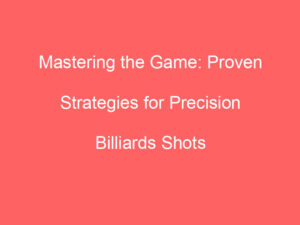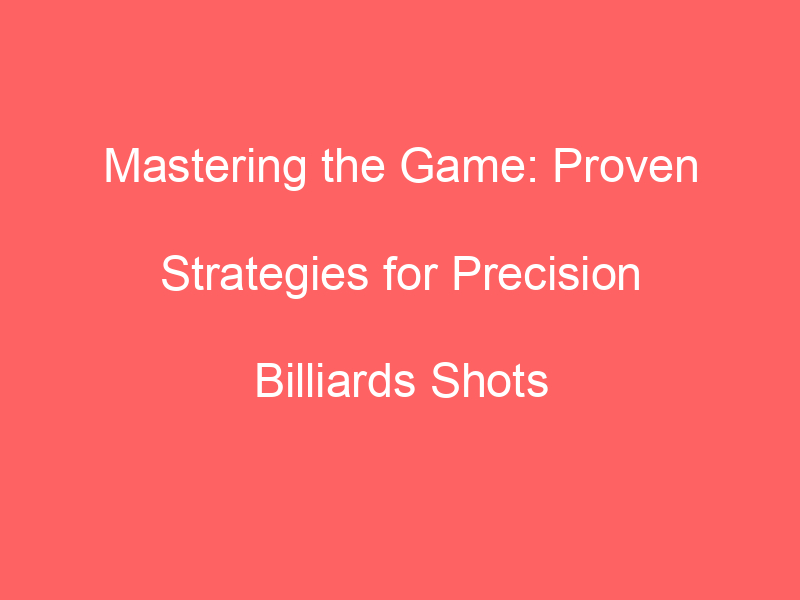
Introduction to Cue Tip Selection
Whether you’re a seasoned pool player or just starting out, understanding the importance of selecting the right cue tip can greatly improve your game. This guide will help you understand the basics of cue tip selection and how it can affect your performance.
-
- Understanding the Importance of the Right Cue Tip
Choosing the right cue tip is more than just picking the one that looks the best. The cue tip is the only part of the cue that actually comes into contact with the cue ball, so it plays a crucial role in how the ball behaves after you hit it. A good cue tip can provide better control, accuracy, and consistency in your shots. It’s like the tires on a car – even the best car won’t perform well with bad tires.
-
- How Cue Tip Selection Affects Your Game
The type of cue tip you choose can have a significant impact on your game. For example, a harder tip can provide more control for power shots, but it may also make it more difficult to apply spin to the ball. On the other hand, a softer tip can make it easier to apply spin, but it may not be as durable or provide as much control for power shots. Therefore, understanding your playing style and what you value most in your shots can help you make the right cue tip selection.
In conclusion, selecting the right cue tip is an essential part of improving your pool game. By understanding the importance of the cue tip and how it can affect your game, you can make a more informed decision and choose the cue tip that best suits your style and needs.
Guide to Choosing the Right Cue Tip
Choosing the right cue tip can significantly improve your game. This guide will help you understand the different games and their specific cue tip requirements.
Understanding Different Games: Billiards, Snooker, and Pool
Billiards, Snooker, and Pool are all cue sports, but they have different rules and require different skills. This also means that they have different cue tip requirements.
-
- Differences in cue tip requirements for each game
Billiards often requires a medium to hard cue tip to control the heavier balls. Snooker players usually prefer a softer tip for better spin control. Pool players often choose a medium tip for a balance between control and power.
-
- Case study: Professional players’ cue tip choices
Let’s look at some professional players and their cue tip choices. Ronnie O’Sullivan, a famous Snooker player, uses a softer tip for better control. On the other hand, Efren Reyes, a renowned Pool player, uses a medium tip for a balance between power and control.
Understanding the game you play and the cue tip requirements can help you choose the right cue tip. Remember, the right cue tip can significantly improve your game.
Decoding Cue Tip Types
Understanding the different types of cue tips is essential in choosing the right one for your game. Let’s decode the three main types: soft, medium, and hard cue tips.
-
Soft Cue Tips
Soft cue tips are known for their excellent grip on the cue ball, allowing for more spin and control. They are ideal for players who prefer a delicate touch and precise shots. However, they tend to wear out faster and require more frequent replacements.
-
Medium Cue Tips
Medium cue tips strike a balance between control and durability. They offer a good amount of spin, but not as much as soft tips. They are less prone to misshaping and are a popular choice among both beginners and experienced players.
-
Hard Cue Tips
Hard cue tips are the most durable of the three. They provide less spin but offer more power for break and jump shots. These tips are less likely to mushroom or deform, making them a favorite among players who prefer a more forceful play style.
| Cue Tip Type | Control | Durability | Preferred Play Style |
|---|---|---|---|
| Soft | High | Low | Precise, controlled shots |
| Medium | Moderate | Moderate | Balance between control and power |
| Hard | Low | High | Powerful, forceful shots |
In conclusion, the type of cue tip you choose can significantly impact your game. It’s important to consider your playing style and the level of control and durability you need before making a decision.
Choosing the Best Cue Tip for Your Style
When it comes to billiards, snooker, or pool, your playing style can greatly influence the type of cue tip you should use. Let’s explore how to assess your style and match it with the perfect cue tip.
- Assessing your playing style
First things first, you need to understand your playing style. Are you a power player who likes to hit the ball hard? Or are you more of a finesse player who relies on precision and control? Maybe you’re somewhere in between? Here’s a simple way to figure it out:
| Playing Style | Description |
|---|---|
| Power Player | You prefer to hit the ball with force, aiming for long shots and break shots. |
| Finesse Player | You rely on accuracy and control, focusing on spin and placement over power. |
| Hybrid Player | You’re a mix of both power and finesse, adjusting your play style as needed. |
- Matching cue tip types to your style
Now that you’ve identified your playing style, it’s time to match it with the right cue tip. Here’s a general guide:
| Playing Style | Recommended Cue Tip |
|---|---|
| Power Player | Hard cue tip. It’s less prone to misshaping and provides a solid hit. |
| Finesse Player | Soft cue tip. It offers more control and spin on the ball. |
| Hybrid Player | Medium cue tip. It’s the best of both worlds, offering a balance of control and power. |
Remember, these are just suggestions. The best cue tip for you is the one that feels the most comfortable and enhances your game. Don’t be afraid to experiment until you find the perfect match!
Deep Dive into Cue Tip Material
When it comes to playing pool, the cue tip material plays a significant role in your game. Let’s take a closer look at the different types of cue tip materials and how they can affect your performance.
Understanding Cue Tip Materials
There are three main types of cue tip materials that are commonly used: leather, phenolic resin, and fiber. Each of these materials has its unique properties and can impact your game in different ways.
-
- Leather Cue Tips
Leather is the most traditional material used for cue tips. It’s known for its flexibility and ability to grip the ball well. Leather tips come in different hardness levels, from soft to hard, allowing players to choose based on their playing style. Soft leather tips provide more spin but wear out faster, while hard leather tips are more durable but offer less spin.
-
- Phenolic Resin Cue Tips
Phenolic resin is a type of plastic that is extremely hard and durable. Cue tips made from this material are known for their power and precision. However, they offer less control and spin compared to leather tips. Phenolic resin tips are often used by players who prefer power shots and break shots.
-
- Fiber Cue Tips
Fiber cue tips are a budget-friendly option that offers a balance between control and power. They are harder than leather tips but softer than phenolic resin tips. Fiber tips are a good choice for beginners or casual players who are not ready to invest in more expensive cue tips.
Understanding the different cue tip materials can help you make an informed decision about what type of cue tip to choose. Remember, the right cue tip for you depends on your playing style and personal preference.
Choosing the Right Material for Your Cue Tip
Choosing the right material for your cue tip is a crucial decision that can significantly impact your game. Different materials have their unique pros and cons, and understanding these can help you make an informed choice. Let’s delve into the details.
- Pros and Cons of Different Materials
There are three main types of cue tip materials: leather, phenolic resin, and fiber. Each of these materials has its advantages and disadvantages.
| Material | Pros | Cons |
|---|---|---|
| Leather | Offers excellent control and spin. It’s also durable and widely available. | Requires regular maintenance and may harden over time. |
| Phenolic Resin | Extremely hard and durable. It provides a consistent hit and requires less maintenance. | Offers less control and spin compared to leather. It’s also more expensive. |
| Fiber | It’s a cost-effective option and requires less maintenance than leather. | Offers less control and spin. It’s also less durable than the other two materials. |
- Key Takeaways: Which Material to Choose?
Your choice of cue tip material should depend on your playing style and personal preferences. If you value control and spin, a leather cue tip might be your best bet. However, if you prefer a consistent hit and less maintenance, a phenolic resin cue tip could be the right choice. For those on a budget, a fiber cue tip can be a viable option.
Remember, the right cue tip material can enhance your performance and enjoyment of the game. So, take your time to consider the pros and cons of each material before making a decision.
Cue Tip Maintenance
Keeping your cue tip in top shape is crucial for maintaining your pool game’s precision and consistency. Here are three key steps to ensure your cue tip stays in the best possible condition.
How to Maintain Your Cue Tip
- Regular CleaningRegular cleaning of your cue tip is essential to prevent the buildup of chalk and other debris. This buildup can affect the tip’s performance and cause miscues. To clean your cue tip, gently scrub it with a soft cloth or a specially designed cue tip cleaner. Remember, it’s important to clean your cue tip after every game to keep it in optimal condition.
- Proper StorageProper storage of your cue stick can significantly extend the life of the tip. Always store your cue stick in a cool, dry place and avoid exposing it to extreme temperatures or humidity. A cue case is a great investment, providing protection and making it easier to transport your cue stick without damaging the tip.
- When to Replace Your Cue TipEven with regular cleaning and proper storage, your cue tip will eventually need to be replaced. Signs that it’s time for a new tip include a flattened or hardened surface, a tip that’s worn down to less than one-eighth of an inch, or a tip that no longer holds chalk well. When you notice these signs, it’s time to replace your cue tip to maintain your game’s accuracy and consistency.
By following these steps, you can ensure your cue tip stays in top condition, helping you maintain a high level of play. Remember, a well-maintained cue tip can make a big difference in your game!
Common Cue Tip Problems and Solutions
Even with the best care and maintenance, cue tips can sometimes develop problems that affect your game. Here are some of the most common issues you might encounter and how to solve them:
- Misshapen Cue TipsOver time, the tip of your cue can become misshapen due to repeated impact with the cue ball. This can affect the accuracy of your shots. To fix this, you can use a cue tip shaper or scuffer. These tools can help you reshape the tip and bring it back to its original form.
- Hardened Cue TipsAnother common problem is cue tips becoming too hard. This can happen if the tip dries out or if it’s not used for a long time. A hard tip can make it difficult to control the cue ball. To soften the tip, you can use a cue tip conditioner. This product moisturizes the tip and helps maintain its elasticity.
- Loose Cue TipsLoose cue tips can be a real nuisance. They can cause miscues and even damage your cue. If your tip is loose, it’s best to replace it. You can do this yourself with a cue tip replacement kit or take it to a professional.
Remember, the best way to avoid these problems is regular maintenance. By taking care of your cue tip, you can ensure it lasts longer and performs better, helping you master your game.
Conclusion: Mastering Your Game with the Right Cue Tip
As we wrap up this comprehensive guide, it’s essential to remember that the cue tip is not just a part of your pool stick. It’s the only part that makes contact with the cue ball, and therefore, it plays a pivotal role in your game’s success. Let’s take a quick recap and share some final thoughts on the impact of the right cue tip on your game.
-
- Recap of cue tip selection guide
Throughout this guide, we’ve covered the importance of choosing the right cue tip. We’ve explored different cue tip materials and their impact on your game, and we’ve provided a step-by-step guide to help you make the right choice. Remember, the hardness of the tip, its size, and the material it’s made of, all play a significant role in how the cue ball reacts to your shot.
-
- Final thoughts on the impact of the right cue tip on your game
The right cue tip can significantly improve your game. It can provide better control, accuracy, and consistency in your shots. A well-maintained cue tip can also increase the lifespan of your pool stick, saving you money in the long run. So, invest time in understanding your play style, your cue stick, and the cue tip that suits you best. Remember, the right cue tip is not a luxury, but a necessity for any serious pool player.
In conclusion, mastering your game is not just about skill and practice. It’s also about understanding and using the right equipment. And in the game of pool, the cue tip holds a place of paramount importance. So, choose wisely, maintain regularly, and play passionately!














